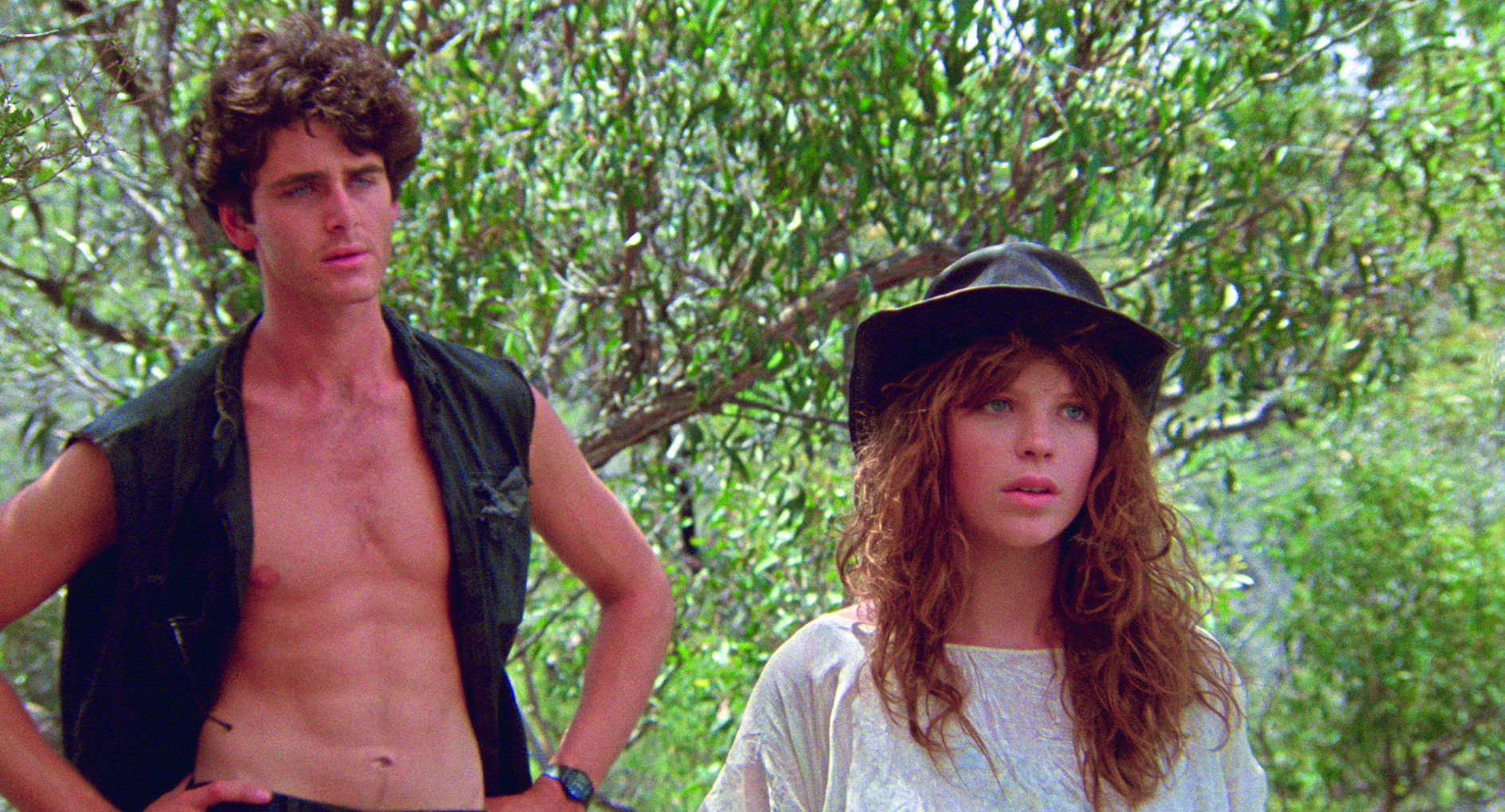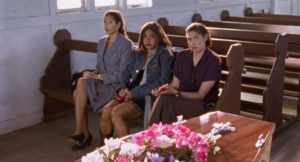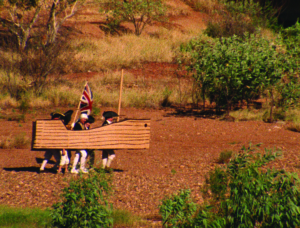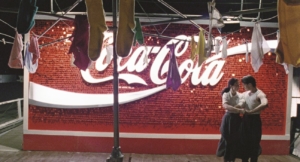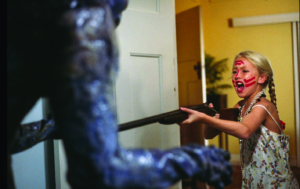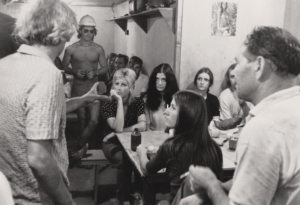Some films are born great; others have greatness thrust upon them. When we talk about cult film in particular, this amorphous notion of ‘greatness’ verges upon the almost ethereal, tied as closely to a given work’s reception as much as – if not more than – its actual content. Philippe Mora’s 1987 film Howling III: The Marsupials is a critical Pandora’s box when it comes to a range of questions that culminate at the intersection of cult-film research, taste, national cinema and screen studies more broadly. Do we approach it critically as an ironically embraced so-bad-it’s-good sequel? As a fascinating auteurist reference point in Mora’s career? As a significant example of how national genre cinemas can both embrace and parody imported iconography, codes and conventions? As a good old-fashioned trash-film hot mess? Howling III is all of these and much, much more. It is a film that knowingly transcends the sum of its parts because those parts are defined precisely by their excesses, exploding in a carnivalesque frenzy that renders the film simultaneously a comedy about horror films as much as an actual horror-comedy film itself.
The enduring legacy of Howling III lies in just how fearlessly it brings an over-the-top ‘Australianness’ to a subgenre marked precisely by its foreign origins, in terms of both Joe Dante’s beloved first film in the series and the werewolf trope more broadly. There is a dynamic of attraction and repulsion at work in the film, which knowingly pulls these broader tropes inwards towards itself while, at the same time, defamiliarising them in an entirely new cultural context, that openly mocks the very cultural flows that form its foundations. Howling III is thus that most precious of cult-film artefacts: a wolf in sheep’s clothing. It is a film with an awful lot to say while superficially looking entirely like a film with absolutely no meaning whatsoever.
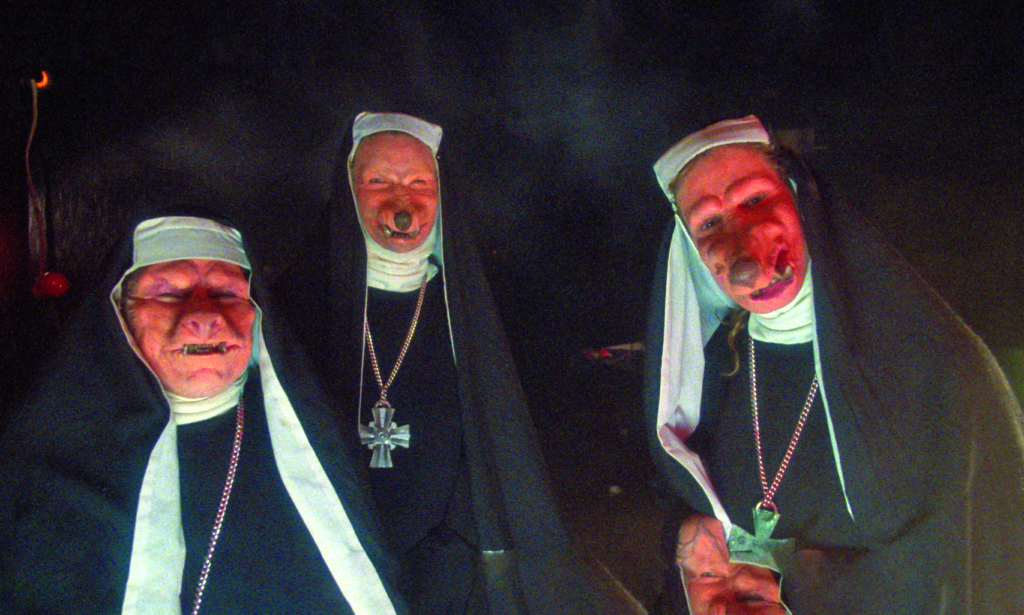
‘Human-to-beast transformations’: Synopsis
The film follows the discovery of a young female marsupial werewolf called Jerboa (Imogen Annesley[1]A young Nicole Kidman had also been considered for the role; see Craig J Clark, ‘The Howling Series Got Howlingly Bad Pretty Quickly’, The A.V. Club, 28 July 2016, <https://film.avclub.com/the-howling-series-got-howlingly-bad-pretty-quickly-179825011>, accessed 5 March 2020. ), who lives unhappily in the feral confines of her rural camp with others of her hybrid species. She stares longingly into a snow globe with a small plastic diorama of the Sydney Opera House inside, dreaming of the big city; but tensions soon arise when Thylo (Max Fairchild) seeks his culturally sanctioned incestuous right to her, and she makes a run for it. In Sydney, it takes only moments for her to come to the attention of Donny (Leigh Biolos), a young man who is working on a horror film called ‘Shape Shifters Part 8’, directed by Jack Citron (Frank Thring). Cast in the lead, Jerboa instantly finds her professional calling, but an unexpected pregnancy and a broader political and scientific investigation into Australian marsupial werewolves put her ambitions on hold, at least for a while.
It is this grander institutional fascination with the possibility of a native werewolf variant that frames Jerboa’s story as well as the film from its outset. Howling III begins with anthropologist Professor Howard Beckmeyer (Barry Otto) showing film footage shot by his father in 1905: a cliché-drenched depiction of a ‘primitive’ Indigenous Australian tribe capturing and killing a strange wolf-like figure. Beckmeyer assumes, naturally, that the wolf figure is not real, and at first the enigma for him is how the tribe were able to make such a lifelike mask. But he is called in for a meeting with the President of the United States (Michael Pate) and told that the National Intelligence Agency has infiltrated Soviet communications security and learned of an ‘Operation Lycanth’, which has involved the recent killing of a werewolf in Siberia. Beckmeyer returns to Australia and, with his colleague Professor Sharp (Ralph Cotterill), digs further into the mystery surrounding his father’s enigmatic film and the possible existence of a native Australian marsupial variation of the Siberia-located Euro-werewolf. Predictably enough, it does not take long for Jerboa and Beckmeyer’s paths to intersect. In Howling III, it is not the moon that triggers human-to-beast transformations, but sex and flashing lights, which Jerboa combines at a cast-and-crew party for the film. Fleeing the party, she is disoriented and hit by a car, which leads her to hospital and, owing to her unusual biology, to the attention of Beckmeyer and Sharp. Although Beckmeyer is delighted to have tangible evidence of a marsupial werewolf – a pregnant one, no less, pouch and all – the government is less excited about the scientific value of the discovery. With the help of her marsupial werewolf-nun sisters, Jerboa is rescued and returned home, and Beckmeyer soon joins forces with her, Donny and the recently defected Soviet ballerina-werewolf Olga (Dagmar Bláhová), to raise their marsupial werewolf children with the help of Kendi (Burnum Burnum), who provides the link between the tribe and the Indigenous spiritual origins of the specifically Australian marsupial werewolf.
‘Chaotic glee’: Production
Somewhat impressively, the film makes even less sense on screen than this brief synopsis might imply. But it is precisely its chaotic glee that makes Howling III such an unambiguous delight. For Australian audiences, especially, there was and remains something defiantly patriotic in ‘Australianising’ the werewolf. Mora himself has proudly stated that ‘we Australians have a marsupial version of everything, including the wolf’ – referring to the thylacine, or Tasmanian wolf (also known as the Tasmanian tiger), from whom his marsupial werewolves evolved – and concluded, ‘Why not put that into the pop zeitgeist? It was comedic – werewolves with pouches! – but I wanted to be pro these creatures.’[2]Philippe Mora, quoted in Bryan Senn, The Werewolf Filmography: 300+ Movies, McFarland & Company, Inc., Jefferson, NC, 2017, p. 127. Emphasis in original. To say Australian werewolf films are thin on the ground is an understatement; aside from treasures such as Mia Kate Russell’s short film Swallow (2013), it is fair to say that, while monster eco-horror is not rare in Australian horror history, filmmakers have generally been less interested in human-to-beast transformations. Instead, more straightforward environmental horror tropes tend to be played out, such as with the killer boar of Razorback (Russell Mulcahy, 1984) or the monstrous crocs of Dark Age (Arch Nicholson, 1987) and Rogue (Greg McLean, 2007).
But, as the third instalment of the Howling series – of which there have been eight films in total, made between 1981 and 2011[3]There are also three novels in the series, all written by Gary Brandner: The Howling (1977), The Howling II (1979) and The Howling III: Echoes (1985). The name of the last of these was granted to Mora in title only, although it is officially recognised as being ‘based on the novel by Gary Brandner’. – Howling III has its own heritage beyond national horror-film history. As Australian film historian Lee Gambin wrote in his 2018 Bram Stoker Award–nominated book The Howling: Studies in the Horror Film, Dante’s original film in the series ‘literally transformed the way in which werewolves were depicted on screen’, and champions it as nothing less than ‘a highly-innovative, influential and socially aware werewolf opus which is quite frankly a masterpiece of modern horror’.[4]Lee Gambin, The Howling: Studies in the Horror Film, Centipede Press, Lakewood, CO, 2018, p. 11. Mora joined the franchise in 1985 to direct Howling II: Your Sister Is a Werewolf (alternatively known as Howling II: It’s Not Over Yet or Howling II: Stirba – Werewolf Bitch). Broadly, critics were not impressed by the second entry, with Bryan Senn writing it off as ‘disastrous’[5]Senn, op. cit, p. 127. and Craig J Clark describing it as ‘a lousy way to pass 91 minutes’.[6]Clark,op. cit. As Mora himself pointed out in an interview with Joe Yanick, however, ‘there is a radical polarized view of this film, but I do think the visceral fact of shooting it in that situation gave it a surreal power – the actual location, the castle’.[7]Philippe Mora, quoted in Joe Yanick, ‘Desecrated Churches, Nazi Hunters, and a New Wave Christopher Lee: The Wild, True Story Behind Howling II’, Diablolique Magazine, 16 July 2015, <https://diaboliquemagazine.com/desecrated-churches-nazi-hunters-and-a-new-wave-christopher-lee-the-wild-true-story-behind-howling-ii/>, accessed 5 March 2020. The ‘situation’ of which Mora speaks is nothing less than extraordinary, and is summarised succinctly by Yanick, one of Howling II’s more vocal critical fans:
It was 1984. With the imminent election of Mikhail Gorbachev, the Cold War was about to enter into its final stages. Tensions were high, and the already rocky relationship between the Soviet Union and the rest of the Western world was waning. It sounds like the most inopportune time for Hollywood to travel into Soviet territory to shoot a horror film, and yet the fact that it is the very backdrop for Philippe Mora’s 1985 eccentric werewolf film, Howling II, is rather fitting. Nothing about this film makes sense, [it’s] kind of its charm. [It’s] spastic, funny (but in a way where the intentionality is hard to tell), dark; you name it and Mora provides it. Howling II is simply a one of a kind film, there is not another werewolf film like it – with the exception of maybe Mora’s follow up Howling III – and there probably will never be another. There really couldn’t be. It’s a complete product of its time and place. Every aspect of the film adds to the overall idiosyncrasy.[8]Yanick, ibid.
It is precisely its chaotic glee that makes Howling III such an unambiguous delight. For Australian audiences, especially, there was and remains something defiantly patriotic in ‘Australianising’ the werewolf.
Filming in this remarkable context, Mora naturally has no small number of extraordinary and clearly fond memories of making Howling II, calling it ‘an unforgettable life experience to make a movie behind the Iron Curtain’.[9]In one particularly eyebrow-raising recollection, Mora confessed: ‘During one scene, we even desecrated the tomb of King Wenceslaus in Prague! The city offered to let us shoot in this sacred place, this crypt, but I was concerned about infringing on this holy shrine, right? But the priests said it was all right because they’d already been trying to get a Bishop from the Vatican to visit the site and reconsecrate it for years. So when we desecrated it, it gave them a reason to send up that Bishop.’ Philippe Mora, quoted in Jim Vorel, ‘Director Philippe Mora on Howling II, Christopher Lee and Gratuitous Sybil Danning’, Paste Magazine, 14 July 2015, <https://www.pastemagazine.com/articles/2015/07/director-philippe-mora-on-howling-ii-christopher-l.html>, accessed 5 March 2020. Initially brought into the Howling franchise by producer John Daly, a personal friend with whom he had previously worked on A Breed Apart (1984), and having not even seen Dante’s original, Mora initially had more practical motivations for making the film: ‘I needed a new station wagon at the time, so I agreed to do Howling II.’[10]ibid.
Of the pair of films in the series that Mora directed, Howling III is the one for which he feels fonder: ‘I think I prefer Howling III by a bit because it was entirely my script,’ he noted in a 2015 interview with Jim Vorel for Paste Magazine.[11]ibid. Although the author of the original novels, Gary Brandner, was apparently less than thrilled (‘Unfortunately, the same guy who botched up Howling II directed Howling III!’, Bryan Senn quotes him as saying[12]Gary Brandner, quoted in Senn, op. cit.), the fact that the cult legacy of Howling III in particular has remained so strong in Australia suggests that the question of authorship renders its value more as a ‘Philippe Mora film’ than a ‘Gary Brandner adaptation’ – and perhaps, retrospectively, reveals why such harsh judgements may have been voiced. At the heart of the film’s deviation from Brandner’s novel, of course, is its very overt and conscious shift away from the original US setting, relocating the film’s narrative to Australia; as critic Martyn Pedler noted, Howling III ‘takes an existing horror franchise and makes it into something uniquely Australian’.[13]Martyn Pedler, ‘“Good Taste Is the Enemy of Art”: An Interview with Philippe Mora’, Metro, no. 161, 2009, p. 96. In a lengthy interview in this magazine, Mora told Pedler about his specifically Australian encounters with international genre cinema in childhood, and how that influenced this film in particular:
As a kid, we lived at the top of Collins Street [in Melbourne], near Fitzroy Gardens, and we saw every movie that came out in the city. I’d write down critiques of every one – in fact, I still have those books. Any genre has its own rules, and it’s fascinating to work in that genre and try to break those rules; to study a genre, and then subvert it to make it more entertaining. That’s how you get a weird movie like Howling III. I just loved the idea of creating an Australian werewolf. I tried to get funding from the Film Finance Corporation – and you should have seen the looks on their faces when I said ‘… it’s about marsupial werewolves’.[14]Philippe Mora, quoted in Pedler, ibid., p. 97.
From a non-Australian perspective, there was a broader scenario that made the timing for Howling III so right for Mora. For Clark, the film
capitalized on the public’s interest in all things Aussie in the wake of Crocodile Dundee’s (Peter Faiman, 1986) massive success by positing the existence of werewolves with pouches, a concept Mora plays straight while sending up every other aspect of the genre, up to and including its mania for sequels.[15]Clark, op. cit.
The question of ‘sending up’ is, of course, crucial to Howling III’s success, and continues a critically recognised tradition in which cult-film audiences are in on the joke, as it were. In the 2015 Paste interview, Mora discussed precisely this balance:
I think when you’re making something like this, you have to keep a straight face. If you let the audience in on the joke too much, it undermines it. Howling II is done pretty straight – my next sequel, Howling III: The Marsupials is less so. There’s a very fine line that has followed me all my career between satire and camp, but the mass audience doesn’t always understand satire – they just think it’s a bad movie. I found that a lot over the years. Believe it or not, a lot of people didn’t realize Marsupials was a gag, a comedy, because it was satire.[16]Mora, quoted in Vorel, op. cit.
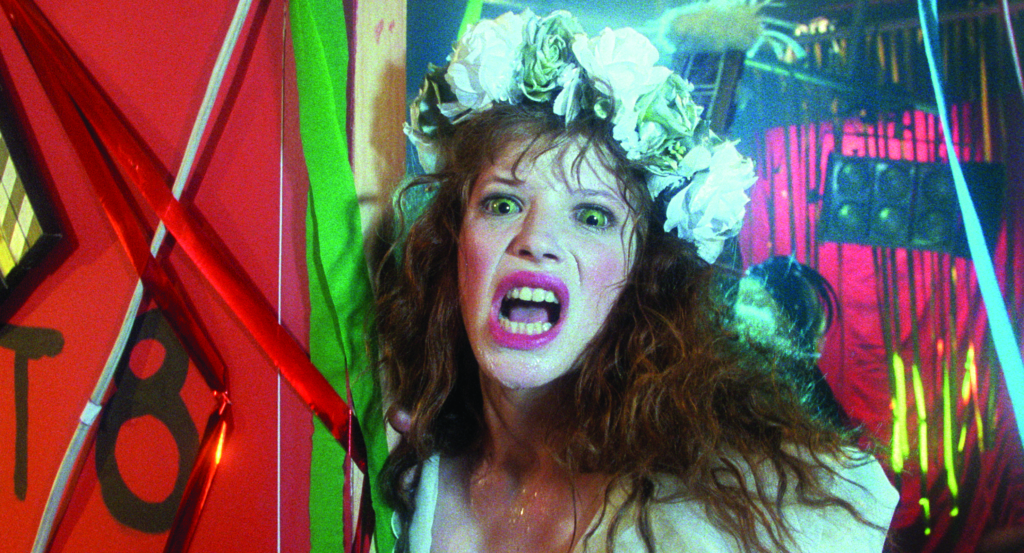
‘Bad taste’ and ‘high art’: Themes
In Carol Laseur’s foundational 1992 essay ‘Australian Exploitation Film: The Politics of Bad Taste’, she notes that, in Howling III and films like it, ‘questions of satire, parody, self-consciousness, intertextual quoting and multi-generic performance play a significant role in both the production and reception of these texts’. For Laseur, ‘generally speaking, this film parodies the monstrous in its various guises’; she lists examples such as ‘American intelligence networks; Aboriginal politics and scientific discovery pertaining to evidence (and impending consequences) of extinction; and evolution of races/species’. Through this strategy, she continues, ‘[i]n one way or another notions of established order are threatened and forms of collective neurosis ridiculed’. Homing in on the making of Jack’s ‘Shape Shifters Part 8’, Laseur argues that this film-within-a-film structure provides ‘an avenue for satirical commentary on distinctions between high and low culture’.[17]Carol Laseur, ‘Australian Exploitation Film: The Politics of Bad Taste’, Continuum: The Australian Journal of Media & Culture, vol. 5, no. 2, 1992, pp. 366–77, available at <https://wwwmcc.murdoch.edu.au/ReadingRoom/5.2/Laseur.html>, accessed 5 March 2020.
This tension between highbrow and lowbrow is not just important when considering the diegesis of Howling III’s narrative itself, but also in how it opens the film up to a much broader critical terrain of cult-film studies that has been dominated by questions of taste and reception. Mora’s interview with Pedler is therefore worth further quoting at length here, as the filmmaker addresses precisely this dynamic through an autobiographical lens:
In the late sixties, I had really quite a meteoric rise as an artist in London. I was highly praised by major critics and had sell-out shows and so on and so forth. What happened was we all became very self-conscious as artists about just selling paintings to an elite group – you had to already be rich to buy a painting! The idea was that we’ve got to appeal to the masses, so we don’t just end up as artists in museums. That’s how I drifted to film. What’s more non-elitist than mainstream movies?[18]Mora, quoted in Pedler, op. cit., p. 98.
In this same interview, Mora noted:
It might seem weird to some, but I see a lot of my movies as Pop Art works. I have no problem with doing a werewolf movie, or a horror movie, just in the same way that Andy Warhol made Frankenstein [Paul Morrissey and Antonio Margheriti, 1973] and Dracula [Paul Morrissey, 1974]. As soon as Pop Art arrived as an art movement, the line between high art and low art became blurred. I think you have to make money with movies. [Vincent] Van Gogh didn’t sell a single painting in his whole lifetime – you can’t do that as a director or you’ll only make one movie.[19]ibid., p. 98.
The question of ‘sending up’ is, of course, crucial to Howling III’s success, and continues a critically recognised tradition in which cult-film audiences are in on the joke, as it were.
In Howling III, these ideas are far from abstracted in Mora’s screenplay; in one of the most hilariously outrageous lines in the entire film, Jack explains his intentions to Jerboa in Thring’s signature deadpan-camp mode of delivery:
This movie is about pop culture. In the sixties Andy Warhol showed us how pop could be high art. In fact, everything is high art – that’s what this is all about. For example, in your first scene you’ll be gang-raped by four monsters.
Thus both ‘Shape Shifters Part 8’ and Howling III itself land us firmly in the terrain of paracinema, a central concept in cult-film studies coined by Jeffrey Sconce in his groundbreaking 1995 essay ‘“Trashing” the Academy: Taste, Excess, and an Emerging Politics of Cinematic Style’. Springboarding off French social theorist Pierre Bourdieu’s influential 1984 book Distinction: A Social Critique of the Judgement of Taste, Sconce speaks to a ‘gradual emergence of a growing and increasingly articulate cinematic subculture, one organized around what are the most critically disreputable films in cinematic history’, which he calls ‘paracinema’. This term applies to a range of films that
includes entries from such seemingly disparate subgenres as “badfilm”, splatterpunk, “mondo” films, sword-and-sandal epics, Elvis [Presley] flicks, government hygiene films, Japanese monster movies, beach-party musicals, and just about every other historical manifestation of exploitation cinema from juvenile-delinquency documentaries to softcore pornography.
Less a genre, subgenre or other kind of taxonomy, paracinema is, for Sconce, more ‘a particular reading protocol […] a counter-aesthetic turned subcultural sensibility devoted to all matter of cultural detritus’.[20]Jeffrey Sconce, ‘“Trashing” the Academy: Taste, Excess, and an Emerging Politics of Cinematic Style,’ Screen, vol. 36, no. 4, 1995, p. 372. Crucially, the value of paracinema for Sconce is as follows:
The study of trash cinema suggests a struggle over the task of cinema scholarship as a whole, especially in terms of defining the relationship between aesthetics and cultural criticism. Whether attacking traditional cultural markets and intellectual institutions as a fan, or attempting to bridge the two worlds as a student, the paracinematic audience presents in its often explicit opposition to the agendas of the academy a dispute over how to approach the cinema as much as a conflict over what cinema to approach.[21]ibid., p. 380.
In one of the many significant responses to Sconce’s essay, academic Matt Hills has identified even more nuance at stake in this critical arena, thus coining the notably playful term ‘para-paracinema’ to articulate that, rather than there being a binary split between trash and non-trash cinema, there is in fact more of a spectrum within the former. This, he suggests, is most visible in how more canonical trash, cult or exploitation films stand in relation to those that are yet to be canonised.[22]Matt Hills, ‘Para-paracinema: The Friday the 13th Series as Other to Trash and Legitimate Film Cultures’, in Jeffrey Sconce (ed.), Sleaze Artists: Cinema at the Margins of Taste, Style, and Politics, Duke University Press, Durham, NC, 2007, pp. 219–39. While Hills focuses specifically on the critical privileging of the Halloween franchise over that of Friday the 13th, his concept of para-paracinema provides a further useful framework through which to consider Howling III.
This, of course, is further complicated by the historically broadly derided status of the sequel itself. But in the case of horror sequels specifically, scholar Carolyn Jess-Cooke has noted that
[g]enre films not only promise predictability, but they also define the viewing experience by offering methods of reconnecting with previous genre films and the intertexts with which those films engaged. Similarly, the sequel makes accessible the processes of reiteration and continuation of a source text.[23]Carolyn Jess-Cooke, Film Sequels: Theory and Practice from Hollywood to Bollywood, Edinburgh University Press, Edinburgh, 2009, pp. 52–3.
Mora’s internal satirising of horror’s signature sequelisation by placing a film called ‘Shape Shifters Part 8’ within a film called Howling III is, therefore, arguably more than cheeky; there’s something fundamentally self-aware within the text itself of precisely the mechanics that Jess-Cooke is identifying, as well as a deliberate attempt to mock the desire to ‘reconnect’ with the ‘source text’ (whether it be Dante’s The Howling or Brandner’s Howling III: Echoes).
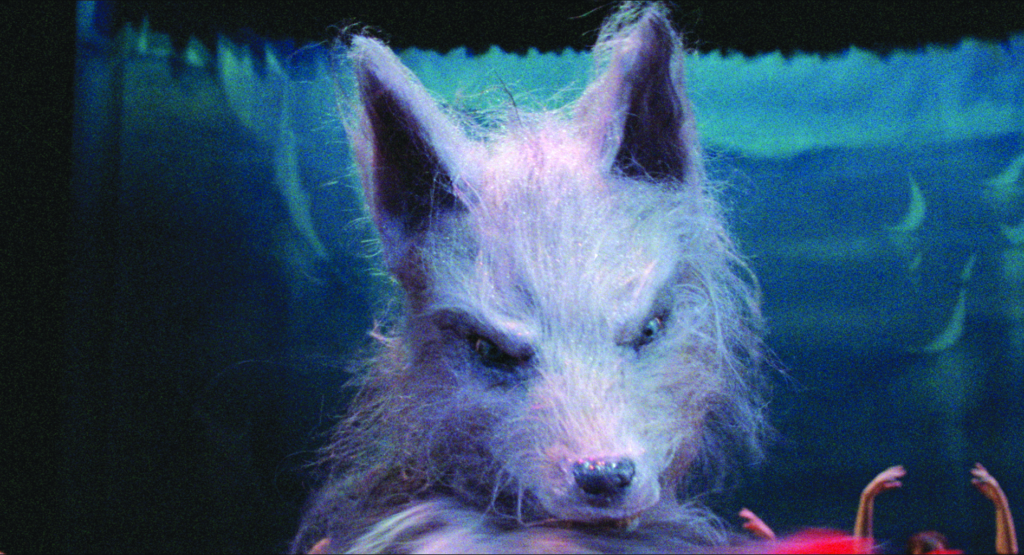
‘A werewolf idyll’: Reception
It is perhaps Mora’s somewhat antagonistic relationship with the unspoken rules of the horror sequel that has made Howling III such a fascinating text to consider in relation to its broader critical response. Certainly, negative reviews are not thin on the ground; critic Scott Aaron Stine unhesitatingly dismisses the film as follows:
What could have been the most innovative, thought-provoking entry in this indefatigable series is instead reduced to being the most inconsistent, slapdash, and hokey film of the bunch. The effects are the quintessential of bad […] the editing and continuity are sloppy, and the actors either amateurish or downright inept. With the haphazard filmmaking portrayed here, it is difficult to see what were once some intriguing concepts underlying the action.[24]Scott Aaron Stine, The Gorehound’s Guide to Splatter Films of the 1980s, McFarland & Company, Inc., Jefferson, NC, and London, 2003, pp. 157–8.
While it may be tempting to frame such a negative response through Stine’s reception context as an American reviewer watching an aggressively Australian film, this collapses immediately in the face of revered New York Times critic Vincent Canby’s comparatively glowing response to the film:
If you see only one werewolf movie this year, you might as well make it ‘Howling III,’ Philippe Mora’s not-altogether straight-faced howler on behalf of lycanthropes’ liberation. Among other things, the Australian-made movie suggests there’s nothing inherently evil about being a werewolf that a little human understanding wouldn’t cure. Mr. Mora and his associates are blunt about it: this anti-werewolf hysteria must stop.
It is perhaps Mora’s somewhat antagonistic relationship with the unspoken rules of the horror sequel that has made Howling III such a fascinating text to consider in relation to its broader critical response.
For Canby, there is, on this front, real value to the film; he celebrates it because it ‘squarely faces the fact that not all werewolves are benign’, and, consequently, ‘when “Howling III” isn’t dealing in werewolf jokes, it comes very close to being a werewolf idyll’.[25]Vincent Canby, ‘Film: Australian Howling’, The New York Times, 13 November 1987, p. C5, available at <https://www.nytimes.com/1987/11/13/movies/australian-howling.html>, accessed 5 March 2020. The positive review from such an esteemed critic surprised many, including Mora himself:
I couldn’t believe how good that review was. I’d made Death of a Soldier [1986], which was a very serious court martial movie, and the same critic, Vincent Canby, didn’t like that. But his review of Howling III put the DVD through the roof. The distributor was thrilled.[26]Mora, quoted in Pedler, op. cit., p. 97.
Rather than a high-profile anomaly, Canby’s instinct that something ideologically profound was boiling away in the belly of the beast that is Howling III was not unique to him. In her compelling 2010 essay ‘Australian Eco-horror and Gaia’s Revenge: Animals, Eco-nationalism and the “New Nature”’, film academic Catherine Simpson presents a theoretically rigorous interrogation of ‘the agency of animals – crocs, pigs, thylacines and marsupial werewolves – in some key Australian eco-horror films from the last 30 years’ including Howling III, noting that ‘[o]n the one hand, these films extend postcolonial anxieties over settler Australian notions of belonging, while on the other, they signify a cultural shift’. She continues, ‘The animals portrayed have an uncanny knack of adapting and hybridizing in order to survive, and thus they [the films and the animals] force us to acknowledge more culturally plural forms of being.’[27]Catherine Simpson, ‘Australian Eco-horror and Gaia’s Revenge: Animals, Eco-nationalism and the “New Nature”’, Studies in Australasian Cinema, vol. 4, no. 1, 2010, p. 43. Describing Howling III as ‘a spoof of the earlier Howling films’, Simpson points out that the fact that the film concludes with the dual romantic cross-species unions of Jerboa–Donny and Beckmeyer–Olga renders it about not merely social justice but also ‘“an interspecies ethics” that can be read as a demand to extend a notion of justice to all those more-than-human others who may indeed be dangerous when provoked but nevertheless have the right to exist’. Accordingly, she argues that films such as Howling III, Dying Breed and Razorback ‘emphasize the interrelationships between humans and non-humans in an evolving concept of Gaia’, which allows her – in the case of Howling III in particular – to identify scholar Donna Harraway’s notion of ‘“a pleasurably tight coupling” between human and animal’. This leads her to conclude that ‘far from being mere entertainment value, exploitation eco-horror cinema can be a rich source with which to examine societal and cultural attitudes towards the environment and its more-than-human others’.[28]ibid., pp. 51–3.
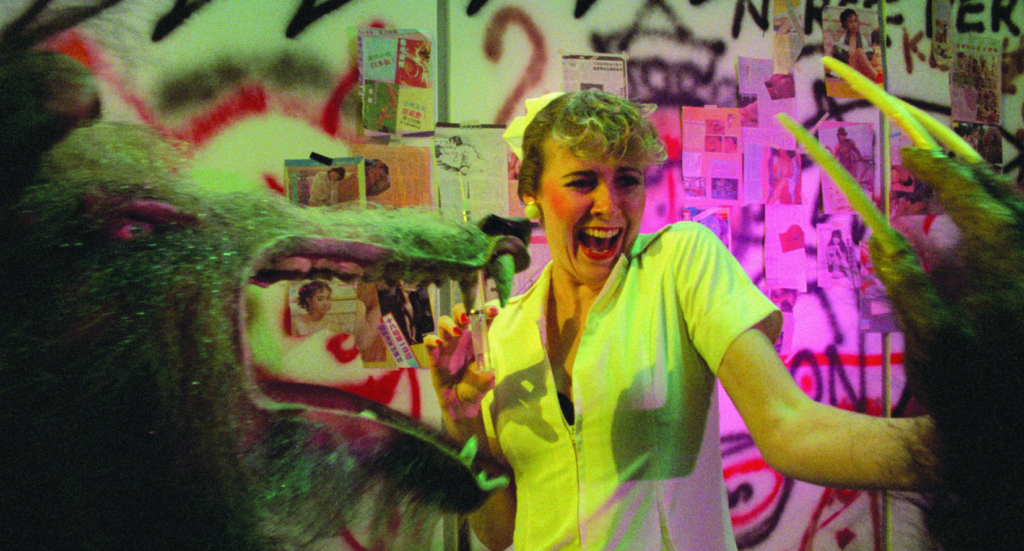
Rather than seeing such diverse responses to Howling III as a critical conundrum, Laseur views these tensions and contradictions as being embedded within the film itself. In terms of Howling III’s representation of Indigenous Australians, for instance, her argument is that the film can be interpreted as – if I were to adopt the contemporary vernacular – both ‘woke’ and ‘problematic’:
Howling III can be read, on the one hand, as a highly insulting representation of Aboriginal culture, drawing a parallel between the Tasmanian tiger and the Australian Aborigine as endangered species. Their extinction is saved only by a transformation into werewolf-marsupials! Or, on the other hand, it can be seen to handle notions of Aboriginality quite perceptively, showing their relationship to the land by playing on the exploitative ventures of large mining companies’ destruction of sacred sites. So, depending on your reading of these motifs […] this film is either highly insulting and/or profoundly aware of the Aboriginal situation in Australia.[29]Laseur, op. cit.
Certainly, from a contemporary perspective, there may be some shifting ground on the two positions Laseur suggested almost thirty years ago. The spectacle of ‘primitive’ Indigenous Australians in Beckmeyer’s father’s film footage is undeniably uncomfortable viewing today for its spectacular representation of reductive stereotypes, additionally privileged by its placement at the very start of the movie. But both Simpson’s and Laseur’s identifications of the ideological complexities and contradictions at play in Howling III demonstrate only too clearly that the film is nowhere near as hollow as its surfaces teasingly invite us to assume.
The question of how to engage with Howling III today has been tantalisingly revealed by Mora to be the precise subject of a mockumentary called The Growling, whose status has been listed on the Internet Movie Database since 2017 as ‘in production’.[30]‘Philippe Mora’s The Growling’, Internet Movie Database, <https://www.imdb.com/title/tt4819938/>, accessed 5 March 2020. In his interview with Yanick, Mora described its premise as ‘that when I made Howling II and Howling III I did not know that many of the cast were actual werewolves’.[31]Mora, quoted in Yanick, op. cit. While the GoFundMe page for the project is now deleted, quotes from it were republished on various horror websites, containing further fascinating details about what the project may entail:
I do not know why, but I have been legally released by my undertaking in 1984 to three governments to never disclose that [werewolves] are real. It’s a truly shocking history, but with my new film I can now reveal that many historical figures and current politicians, world leaders, scientists, movie stars, comedians, religious leaders, executives and others, both savory and unsavory, are lycanthropes. In this film I will take you into the startling MONDO WEREWOLF. Because of the seriousness of the revelations the only way to make the film without censorship is to seek funding from you, the public.[32]Philippe Mora, quoted in Samuel Zimmerman, ‘Philippe Mora’s The Growling to Expose Society’s Werewolves’, ComingSoon.net, 16 June 2015, <https://www.comingsoon.net/horror/news/746333-philippe-moras-growling-expose-societys-werewolves>, accessed 5 March 2020.
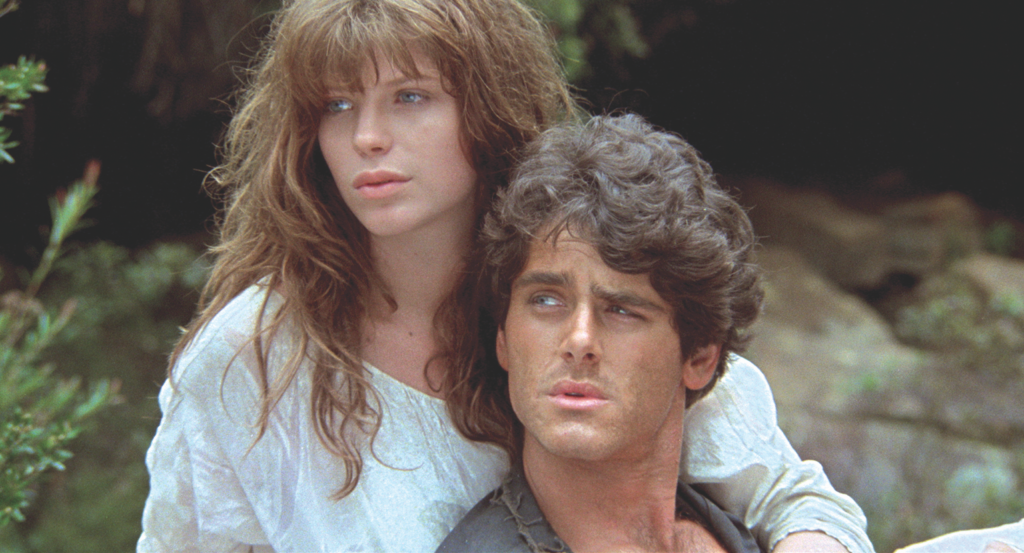
In a charming throwback to the marketing strategies of exploitation legend William Castle, Mora even went as far as adding the following warning to the GoFundMe page: ‘Special note: Early scenes have so shocked a few of my friends that paramedics will be standing by now at all screenings.’[33]ibid. Regardless of what comes of The Growling, this description vividly demonstrates just how successful Mora has been in the past with his Howling films – and Howling III in particular – by both incorporating an intuitive understanding of genre mechanics from a historical perspective and adapting them to the current zeitgeist. As we see in the legendary finale of Howling III, throw Dame Edna Everage presenting an Oscar into the mix and you have an undeniable Australian cult-film classic.
This article has been refereed.
PRINCIPAL CREDITS
Year of release 1987 Length 94 mins Director Philippe Mora Producers Philippe Mora & Charles Waterstreet Director of Photography Louis Irving Editor Lee Smith Production Manager Rosslyn Abernethy Production Designer Ross Major Music Allan Zavod Original Screenplay Philippe Mora
MAIN CAST
Professor Harry Beckmeyer Barry Otto Jerboa Imogen Annesley Thylo Max Fairchild Professor Sharp Ralph Cotterill Donny Martin Leigh Biolos Olga Gorki Dagmar Bláhová Academy Awards Presenter Barry Humphries Jack Citron Frank Thring
Select bibliography
Vincent Canby, ‘Film: Australian Howling’, The New York Times, 13 November 1987, p. C5, available at <https://www.nytimes.com/1987/11/13/movies/australian-howling.html>.
Craig J Clark, ‘The Howling Series Got Howlingly Bad Pretty Quickly’, The A.V. Club, 28 July 2016, <https://film.avclub.com/the-howling-series-got-howlingly-bad-pretty-quickly-1798250112>.
Carol Laseur, ‘Australian Exploitation Film: The Politics of Bad Taste’, Continuum: The Australian Journal of Media & Culture, vol. 5, no. 2, 1992, pp. 366–77, available at <https://wwwmcc.murdoch.edu.au/ReadingRoom/5.2/Laseur.html>.
Martyn Pedler, ‘“Good Taste Is the Enemy of Art”: An Interview with Philippe Mora’, Metro, no. 161, 2009, pp. 96–8.
Bryan Senn, The Werewolf Filmography: 300+ Movies, McFarland & Company, Inc., Jefferson, NC, 2017, pp. 127–9.
Catherine Simpson, ‘Australian Eco-horror and Gaia’s Revenge: Animals, Eco-nationalism and the “New Nature”’, Studies in Australasian Cinema, vol. 4, no. 1, 2010, pp. 43–54.
Jim Vorel, ‘Director Philippe Mora on Howling II, Christopher Lee and Gratuitous Sybil Danning’, Paste Magazine, 14 July 2015, <https://www.pastemagazine.com/articles/2015/07/director-philippe-mora-on-howling-ii-christopher-l.html>.
Joe Yanick, ‘Desecrated Churches, Nazi Hunters, and a New Wave Christopher Lee: The Wild, True Story Behind Howling II’, Diablolique Magazine, 16 July 2015, <https://diaboliquemagazine.com/desecrated-churches-nazi-hunters-and-a-new-wave-christopher-lee-the-wild-true-story-behind-howling-ii/>.
Endnotes
| 1 | A young Nicole Kidman had also been considered for the role; see Craig J Clark, ‘The Howling Series Got Howlingly Bad Pretty Quickly’, The A.V. Club, 28 July 2016, <https://film.avclub.com/the-howling-series-got-howlingly-bad-pretty-quickly-179825011>, accessed 5 March 2020. |
|---|---|
| 2 | Philippe Mora, quoted in Bryan Senn, The Werewolf Filmography: 300+ Movies, McFarland & Company, Inc., Jefferson, NC, 2017, p. 127. Emphasis in original. |
| 3 | There are also three novels in the series, all written by Gary Brandner: The Howling (1977), The Howling II (1979) and The Howling III: Echoes (1985). The name of the last of these was granted to Mora in title only, although it is officially recognised as being ‘based on the novel by Gary Brandner’. |
| 4 | Lee Gambin, The Howling: Studies in the Horror Film, Centipede Press, Lakewood, CO, 2018, p. 11. |
| 5 | Senn, op. cit, p. 127. |
| 6 | Clark,op. cit. |
| 7 | Philippe Mora, quoted in Joe Yanick, ‘Desecrated Churches, Nazi Hunters, and a New Wave Christopher Lee: The Wild, True Story Behind Howling II’, Diablolique Magazine, 16 July 2015, <https://diaboliquemagazine.com/desecrated-churches-nazi-hunters-and-a-new-wave-christopher-lee-the-wild-true-story-behind-howling-ii/>, accessed 5 March 2020. |
| 8 | Yanick, ibid. |
| 9 | In one particularly eyebrow-raising recollection, Mora confessed: ‘During one scene, we even desecrated the tomb of King Wenceslaus in Prague! The city offered to let us shoot in this sacred place, this crypt, but I was concerned about infringing on this holy shrine, right? But the priests said it was all right because they’d already been trying to get a Bishop from the Vatican to visit the site and reconsecrate it for years. So when we desecrated it, it gave them a reason to send up that Bishop.’ Philippe Mora, quoted in Jim Vorel, ‘Director Philippe Mora on Howling II, Christopher Lee and Gratuitous Sybil Danning’, Paste Magazine, 14 July 2015, <https://www.pastemagazine.com/articles/2015/07/director-philippe-mora-on-howling-ii-christopher-l.html>, accessed 5 March 2020. |
| 10 | ibid. |
| 11 | ibid. |
| 12 | Gary Brandner, quoted in Senn, op. cit. |
| 13 | Martyn Pedler, ‘“Good Taste Is the Enemy of Art”: An Interview with Philippe Mora’, Metro, no. 161, 2009, p. 96. |
| 14 | Philippe Mora, quoted in Pedler, ibid., p. 97. |
| 15 | Clark, op. cit. |
| 16 | Mora, quoted in Vorel, op. cit. |
| 17 | Carol Laseur, ‘Australian Exploitation Film: The Politics of Bad Taste’, Continuum: The Australian Journal of Media & Culture, vol. 5, no. 2, 1992, pp. 366–77, available at <https://wwwmcc.murdoch.edu.au/ReadingRoom/5.2/Laseur.html>, accessed 5 March 2020. |
| 18 | Mora, quoted in Pedler, op. cit., p. 98. |
| 19 | ibid., p. 98. |
| 20 | Jeffrey Sconce, ‘“Trashing” the Academy: Taste, Excess, and an Emerging Politics of Cinematic Style,’ Screen, vol. 36, no. 4, 1995, p. 372. |
| 21 | ibid., p. 380. |
| 22 | Matt Hills, ‘Para-paracinema: The Friday the 13th Series as Other to Trash and Legitimate Film Cultures’, in Jeffrey Sconce (ed.), Sleaze Artists: Cinema at the Margins of Taste, Style, and Politics, Duke University Press, Durham, NC, 2007, pp. 219–39. |
| 23 | Carolyn Jess-Cooke, Film Sequels: Theory and Practice from Hollywood to Bollywood, Edinburgh University Press, Edinburgh, 2009, pp. 52–3. |
| 24 | Scott Aaron Stine, The Gorehound’s Guide to Splatter Films of the 1980s, McFarland & Company, Inc., Jefferson, NC, and London, 2003, pp. 157–8. |
| 25 | Vincent Canby, ‘Film: Australian Howling’, The New York Times, 13 November 1987, p. C5, available at <https://www.nytimes.com/1987/11/13/movies/australian-howling.html>, accessed 5 March 2020. |
| 26 | Mora, quoted in Pedler, op. cit., p. 97. |
| 27 | Catherine Simpson, ‘Australian Eco-horror and Gaia’s Revenge: Animals, Eco-nationalism and the “New Nature”’, Studies in Australasian Cinema, vol. 4, no. 1, 2010, p. 43. |
| 28 | ibid., pp. 51–3. |
| 29 | Laseur, op. cit. |
| 30 | ‘Philippe Mora’s The Growling’, Internet Movie Database, <https://www.imdb.com/title/tt4819938/>, accessed 5 March 2020. |
| 31 | Mora, quoted in Yanick, op. cit. |
| 32 | Philippe Mora, quoted in Samuel Zimmerman, ‘Philippe Mora’s The Growling to Expose Society’s Werewolves’, ComingSoon.net, 16 June 2015, <https://www.comingsoon.net/horror/news/746333-philippe-moras-growling-expose-societys-werewolves>, accessed 5 March 2020. |
| 33 | ibid. |
